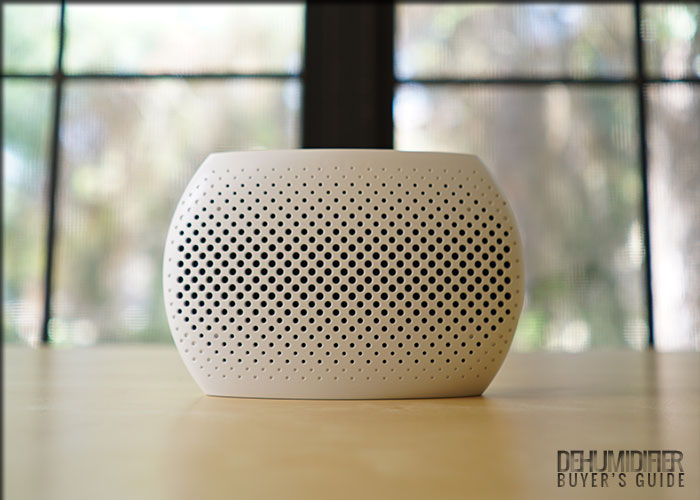
The Iwotou renewable mini dehumidifier is one of several such dehumidifiers we purchased for review in 2015. The Iwotou works in much the same way as the Eva-Dry E-333 and E-500, and similar units from Ivation and Gurin, which we’ve also reviewed and for which you can read our reviews by visiting our desiccant dehumidifier buyer’s guide page. Again, all of these dehumidifiers work almost exactly the same way. An outer plastic casing houses a renewable chemical desiccant (for the Iwotou and most other similar units this is a silica gel) which facilitates dehumidification. The desiccant removes moisture from the air by a process known as adsorption. Once the desiccant is fully saturated it needs to be recharged. Recharging the desiccant involves plugging the dehumidifier into a wall outlet for 10 to 12 hours. Because recharging the desiccant involves liberating moisture from it, you definitely want to plug in the dehumidifier in a well ventilated room that you don’t need at a specific humidity. Plugging in the dehumidifier in the same space you’re attempting to dehumidify will essentially negate all of the dehumidification it’s done so be careful not to do so.
As we described above, the Iwotou works almost exactly the same way as both Eva-Dry mini dehumidifiers work. Below we’ll discuss the differences between the Iwotou and both Eva-Dry products, specifically, only because they’re the top rated products in the rechargeable mini dehumidifier category. If you’re looking to purchase this Iwotou mini dehumidifier you’re most likely looking to see how it compares to the best in the category (as opposed to the worst). We compare it to the Eva-Dry E-333 and E-500 below.
In our E-500 review we make the recommendation that you buy the E-333 instead. We make this recommendation for many reasons, the two most important of which are price and moisture removal rate. Let’s talk about the latter reason first and tie it into our review of the Iwotou mini dehumidifier. The E-500 can remove up to 8 ounces of moisture before needing a recharge. The E-333 only removes up to 6 ounces before needing a recharge. The E-500, however, takes up to 8 weeks to reach its 8 oounce capacity. The E-333 only takes up to 4 weeks to reach its 6 ounce capacity. Clearly, the E-333 removes moisture faster than the E-500 and with only a slight capacity disadvantage compared to the E-500.
The Iwotou has a hygroscopic capacity (which we’ll simply refer to as its “capacity” from now on) of 250 mL which equates to about 8.5 ounces. Thus the Iwotou has similar capacity to the 8 ounce capacity of the E-500 and a slightly greater capacity than the E-333. Unfortunately, the manufacturer doesn’t tell us how long the device will take to reach this capacity. Due to time constraints (we only had the product in our possession for a month for review), we were unable to test this for ourselves. We can only assume that it has a similar moisture removal rate to both the E-333 and E-500. In other words, we think it’s safe to assume that the Iwotou takes anywhere from a month or two to reach capacity. Whether it takes longer or shorter than either unit we do not know. We can only assume that the time it takes to reach capacity is similar to both Eva-Dry units. This assumption is based on the fact that one, the Iwotou has a very similar size and very similar dimensions to both Eva-Dry dehumidifiers; two, it uses exactly the same desiccant material (SiO2); and three, it requires approximately the same amount of time to recharge. The bottom line – as far as moisture removal rate is concerned we’re unsure as to whether the Iwotou removes moisture faster than either the E-333 or E-500 but we do feel strongly that it should have similar rates to both.
Recall that we recommended the E-333 over the E-500 despite the fact that the E-500 has a slightly greater capacity and thus requires less frequent recharging. The Iwotou has a capacity very close to that of the E-500. We also do not recommend the Iwotou over the E-333 because of its greater capacity.
Finally, let’s discuss price. A big reason why we recommended the E-333 over the E-500 was because we felt that the extra $5 to $10 (approx.) you need to spend to get the E-500 isn’t worth its slightly greater capacity. The E-333 is also, of course, faster at removing moisture. The same logic applies to our comparing the E-333 to the Iwotou. The Iwotou and E-500 are similarly priced. The Iwotou is also $5 to $10 (approx.) more expensive than the E-333 (at the time of the writing of this review). Again, we feel strongly that its slightly greater capacity isn’t worth the few dollars extra you need to pay to get that extra capacity. In the E-500′s case we were sure that it removed moisture less quickly than the E-333. We don’t know for sure whether that’s true for the Iwotou compared to the E-333. Regardless, our recommendation is that you save a few dollars and buy the E-333 instead of the Iwotou. For our full E-333 review click here. In the same review we also discuss how to properly use any renewable desiccant mini dehumidifier. These dehumidifiers are designed for very specific applications and although buying the best one is important (we just unequivocally told you that the E-333 is the best option among all of the renewable desiccant dehumidifiers we’ve reviewed), buying the best one for the wrong application won’t do you any good. Our recommendation is that you carefully read our E-333 review to find out how to use this type of dehumidifier for the right applications.